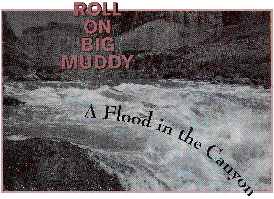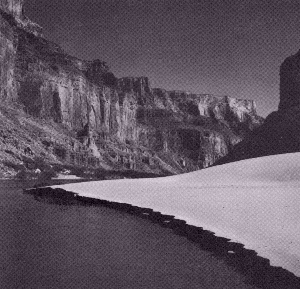

|
|---|

Spring 1996 |
The following article is an excerpt taken from the Spring 1996 issue of the Colorado Plateau Advocate,
a publication of the GRAND CANYON TRUST.
by Tom Moody, Conservation Consultant for the Grand Canyon Trust
 ". . . its immediate tide presenting a
". . . its immediate tide presenting a
formidable host of snarling waters
whose angry roar, reverberating
wildly league after league between
giant rock-walls carved through the
bowels of the earth . . ."
-- Fredrick Dellenbaugh,
The Romance of the Colorado River, 1902
When Frederick Dellenbaugh joined John Wesley Powell's crew on the 1871 exploration of the Colorado River, he viewed a river much different than the one we see today. Stripped of vegetation, the river banks were dominated by massive sand bars and bare rock, which abutted a pulsing, muddy river. Annual floods were a dominant presense. Each spring a torrent of muddy snow-melt tumbled from the distant Rockies through the canyons of the Colorado. These violent floods scoured the banks, replenishing the system's sediment supply. These were the dynamics that carved the Grand Canyon.
The Glen Canyon Dam changed all that. Today, the sand bars have been eroded by over thirty years of clear-water releases from Glen Canyon Dam. Periodic flood flows, unplanned and uncontrolled, have sent much of the sediment downstream.
 But in late March, flood waters will again roll through Grand Canyon, thanks to the efforts of the Trust and other environmental groups. But unlike the damaging flooding that took place through mismanagement of the dam during the 1980s, this flood is specially designed to benefit the downstream resources of the Colorado River. It won't restore pre-dam conditions, but it has the potential to substantially restore the river's sediment deposition. Large sand beaches will once again be dynamic elements of the ecosystem.
But in late March, flood waters will again roll through Grand Canyon, thanks to the efforts of the Trust and other environmental groups. But unlike the damaging flooding that took place through mismanagement of the dam during the 1980s, this flood is specially designed to benefit the downstream resources of the Colorado River. It won't restore pre-dam conditions, but it has the potential to substantially restore the river's sediment deposition. Large sand beaches will once again be dynamic elements of the ecosystem.
The Grand Canyon Trust has fought for this since 1989. In 1992 we helped push through the Grand Canyon Protection Act (GCPA), which mandated that downstream natural resources be considered in managing Glen Canyon Dam. Most of the West's rivers are controlled by dams, and this is a precedent-setting breakthrough.
This experiment, developed by scientists working on the recently completed environmental impact statement mandated by the GCPA, has multiple purposes. Fundamentally, it is an attempt to use dam operations to repair downstream habitats, instead of destroying them. The most visible result will be the deposition of sand on the canyon's beaches. But equally important to the native plants and animals will be the flood's potential to reshape the sand bars above and below river level. It is expected that the high water will reconstruct backwaters that are important as nurseries for native fish species.
This strategy is a balancing act between sediment and energy. Today most of the sediment carried down the river is trapped in the upper end of Lake Powell - most, but not all. Fortunately, almost 14 percent of the pre-dam volume of sediment still empties into the canyon from the Paria and Little Colorado Rivers. This is the sediment we can use to rebuild the beaches. But how do we keep the sediment in place? The river is not only sediment-starved, but it is also much less energenetic. High flows average 20,000 cfs rather than 100,000. Sediment that once was carried downstream now slowly accumulates in the bottom of the main channel. And that sand is available to redeposit on the beaches.
Dellenbaugh was absolutely correct when he observed a hundred years ago that "the water is the master sculptor of this wierd, wonderful land." It was at work on a grand scale for millions of years until man plugged the river with Glen Canyon Dam. With this spring's experimental planned flood, it will have a chance to do its work again, though on a tragically smaller scale.
The Grand Canyon Trust will keep vigilant and will keep you alerted to new developments. This is a great victory for the Trust and to all of the others who have worked to see it happen.
![]()
| -- Tom Moody |
|
|
|---|
|
|---|